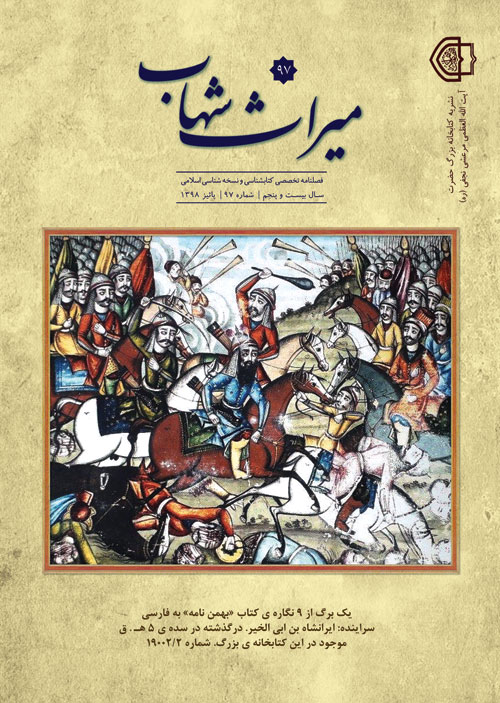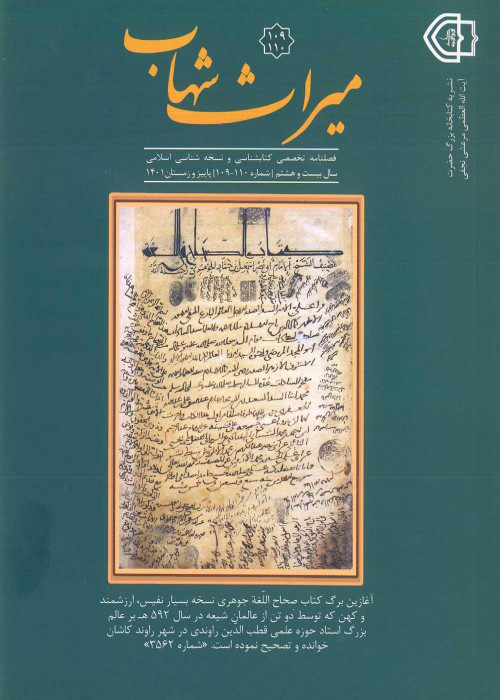فهرست مطالب

نشریه میراث شهاب
پیاپی 97 (پاییز 1398)
- تاریخ انتشار: 1399/06/10
- تعداد عناوین: 8
- فهرست نسخ خطی
-
صفحه 3
- مقالات
-
صفحه 43
- نسخه شناسی
-
صفحه 135
-
صفحه 191
- متن پژوهی
-
اسرار یقین و شک / تصحیح و ترجمه رساله: الوظیفه الکافیه فی مقام استنباط الاحکام الشرعیه الفرعهصفحه 197
- قم پژوهی
-
صفحه 229
-
Page 3
The present article introduces about 50 manuscripts that Ayatollah Seyyed Shahab al-Din Marashi donated or dedicated them as waqf to the library of Astan Hazrat Masoumeh (Sayyida Masoumah Holy Shrine), mostly around 1952 to 1967. Among these book manuscripts, the following are noteworthy: Taqreerat e Abhath e Sharif ul-Ulama (transcripts of Sharif ul-Ulama’s Lectures) in his own handwriting; Mustadrak ul-Alfayn (Supplementation of al-Alfayn) on Imamate reproduced from the original manuscript of the author; Sharayi’ ul-Islam (Laws of Islam) an old version dated back to 1579 AD (987 A.H.); Qawanin ul-Usul (the Rules of Methodology of Jurisprudence) by Mirza Abu al-Qasemj al-Qommi, a manuscript handwritten during the author’s lifetime; Irshad ul-Azhan (the Guide of the Minds) by Allamah al- Hilli, printed in 1572 AD; Al-Mukhtasar al-Nafi’a (the Beneficial Summary) dated 1573 AD; Ziyaratnameh of Imam al-Ridha (Al-Salaam Be upon Him) (Ziyarah-text) created by Mirza Yahya Isfahani dated 1885 AD, handwritten by the author himself.
Keywords: Najafi Mar’ashi’ Seyyed Shahab al-din-donated, endowedbooks, Sayyida Masoumah Holy Shrine library - manuscripts, manuscripts -libraries in Qom -
Page 43
The article contains a collection of research tips and benefits, mainly on four topics: a. Safavid-related points such as: Christian evangelical activities, the spread of philosophy, literature and public culture, and religious stories during this period and the Shahnameh attributed to King Ismail II; b. points referring to Qazi Abd al-Jabbar al-Mu’tazeli like: Dala’il al-Nubuwwah (proofs of prophethood) written by him, especially on matters relating to Christianity; his account on Paul; c. Materials related to the position of ancient Bahrain in Shiite studies such as: its destroyed villages, Suhaimiyeh village in Ehsa and Ali ibn Jafar Ehsaei, the scholar of this village, their place in preserving and transmitting the ancient Imami heritage such as Tafsir Furat Ibn Ibrahim al-Kofi, Najjar Ehsaei family; d. Usage of manuscripts, especially local historiography, and recording and correcting ancient strange names. In addition, various points such as ‘Ale Khatun al-Ameli and ancient tombstones have been addressed.
Keywords: Safavid history - points, Qazi Abd al-Jabbar al-Hamadani-points, Bahrain - Shia history - points, manuscripts - scientific usage, ‘Ale Khatunal-Ameli, Christianity - evangelical activities, philosophy, Paul, Suhaimiyah, Najjar Ehsai family -
Page 121
Reviewing the English summary of the Quran, ‘The Study Quran’ (hereinafter “Quran of Cognition”) by Sayyed Hossein Nasr, is the main theme in this article. The translation features, the English equivalents adopted for Arabic terms like qisas, ul il-albab and taqwa, literal translations, translation of technical terms and phrases in this book are among the issues reviewed by the author.
Keywords: Nasr, Sayyed Hossein, The Study Quran (book)-review, Englishtranslations of the Quran, Quranic Commentaries - in English, The Qurantranslation features -
Page 135
The author has compiled about 200 manuscripts on genealogy, listing them based on their title alphabetical order (from haraq z to the end), mentioning the specifications whether manuscript or print in both Farsi and Arabic. The present article, which is in continuance of the author’s previous articles in the same journal, categorized these considering themes such as: the Prophet and Imams, families, Imamzadegan (Imams’ descendants), sects, dynasties of kings, tribes, scholars, and cities.
Keywords: genealogy - references, genealogical books - bibliography andcodicology, stemmata - thematic classification, manuscripts-genealogy -
Page 191
Man la yahdhuruhu al-faqeeh (literally: Whom a faqeeh is not present before him) represents one of the four main Shia hadith collection books compiled by Sheikh al-Sadouq in Fourth Hijri century. Many scientific efforts have been made on that so far, including transcription and commentaries. The author here has identified a precious manuscript of this book kept in Princeton university library, handwritten by Mohammad-Zaman Qommi in 1707 AD. Seals, possessions, notes, signs of rhetoric, and images of some the pages are included.
Keywords: Man la yahdhuruhu al-faqeeh (book) – manuscripts, Qommi, Mohammad-Zaman, writing transcript of Man la yahdhuruhu al-faqeeh, scribers on manuscripts-12th Hijri century, Shia hadith manuscripts -
Page 197
After addressing biography of Sayyed Mohammad-Baqer Khosrowshahi, a prominent scholar in Khosrowshah region of Azerbaijan (1870 - 1943), the author describes ten of his books on jurisprudence and methodology of jurisprudence (fiqh and usul al-fiqh). Then, explaining a little about what usul al-fiqh is and how it looks into foundations and bases of inferring religious rules and shariah, he reviews the main text of the treatise Al-Wadhifat al-Kafeeya which has not yet been published. This book is on the nature of ilm and jahl (knowledge and ignorance) and their level of light and darkness, reason and argument that ends in certainty, and our duty when we are in doubt and bewildered. The main content of the book has been printed based on its manuscript existing in Majlis library and its Persian translation follows it.
Keywords: Khosrowshahi, Sayyed Mohammad-Baqer (1870 - 1943), biography, works, Al-Wadheefat al-Kafiya (book), Khosrowshah - scholars, Azeri Fuqaha (jurisprudents), methodology of jurisprudence, certainty andspeculation, knowledge, ignorance -
Page 229
Since its antiquity dates back to thousands of years ago, Qom’s history includes Zoroastrianism. More than forty fire temples, whose names and addresses can be found in related sources, have been introduced in this article. By Old Qom, the author, though, means Komidan, a place vaster than the current city of Qom. The temples are listed in alphabetical order. Among the most notable sources cited by the author is ‘The History of Qom’ written by Hassan ibn Mohammad al-Ash’ari in 4th century.
Keywords: Qom –fourth century history, Komidan, Iran - Qom fire temples, history of Qom (the book), Qom-fire temples


